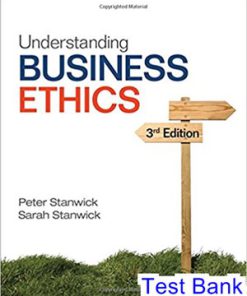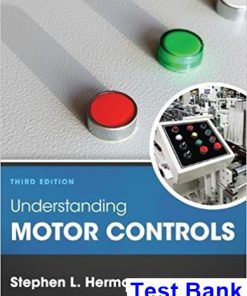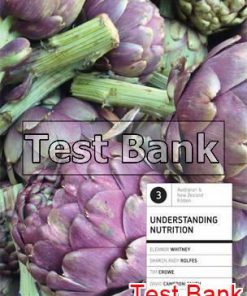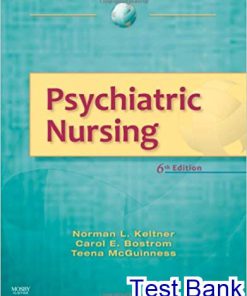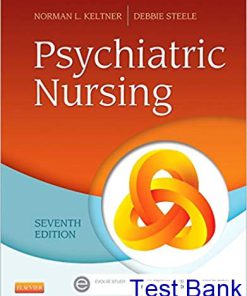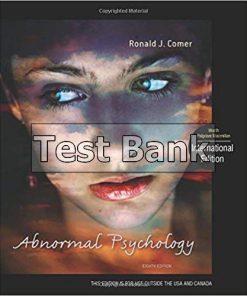Understanding Emotions 3rd Edition Keltner Test Bank
You may also like
Understanding Emotions 3rd Edition Keltner Test Bank
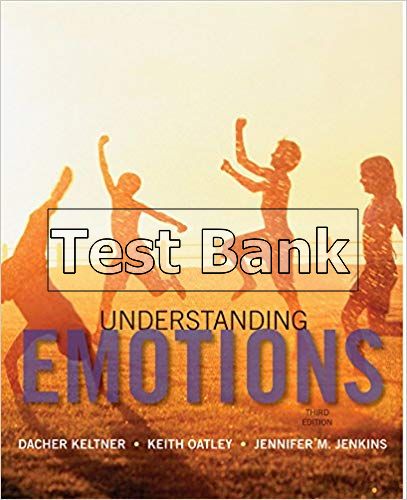
Product details:
- ISBN-10 : 111814743X
- ISBN-13 : 978-1118147436
- Author: Dacher Keltner
Dacher Keltner, Keith Oatley, and Jennifer Jenkins’s Understanding Emotions, 3rd Edition emphasizes the value of emotions and explores the latest research with practical concerns for clinical problems, education and everyday understanding. The text extends across a broad range of disciplines and covers the entire lifespan from infancy to adulthood. It includes sections on the study of emotion, the different elements of emotion, evidence of how emotions govern and organize social life, and emotion and individual functioning, including psychological disorders and wellbeing.
Table contents:
Part I Perspectives on Emotions 1
1 Approaches to Understanding Emotions 3
Introduction 4
What Is an Emotion? First Ideas 5
Nineteenth-Century Founders 6
Charles Darwin: The Evolutionary Approach 6
William James: The Bodily Approach 10
Sigmund Freud: The Psychoanalytic Approach 10
Philosophical and Literary Approaches 12
Aristotle and the Ethics of Emotions 12
René Descartes: Philosophically Speaking 15
George Eliot: The World of the Arts 17
Brain Science Psychology Sociology and Anthropology 18
John Harlow Tania Singer: Toward a Brain Science of Emotion 19
Magda Arnold Sylvan Tomkins: New Psychological Theories 22
Erving Goffman Arlie Russell Hochschild and Lila Abu-Lughod: Emotions as Moral Dramas Involving Selves and Others 24
Empirical Inspirations for a New Science of Emotion 26
What Is an Emotion? A Framework 28
The Emotional Realm: Emotions—Moods—Dispositions 29
Episodes of Emotion 30
Moods and Sentiments 30
Emotional Disorders 30
Personality and Temperament 30
Summary 31
To Think About and Discuss 31
Further Reading 31
2 Evolution of Emotions 32
Elements of an Evolutionary Approach 33
Selection Pressures 33
Adaptation 35
Natural Design for Gene Replication 37
An Evolutionary History of Human Emotions 41
Insights from Modern Hunter-Gatherers 41
Insights from Nonhuman Primates 43
Human Ancestry 47
Evolution of Symbolic Representation and Language 49
Emotions as Bases of Human Relationships 51
Emotions That Promote Attachment 52
Emotions and Negotiation of Social Hierarchy 54
Emotions Affiliation and Friendship 54
Collective Emotion and Preference for In-Groups 55
Summary 57
To Think About and Discuss 57
Further Reading 58
3 Cultural Understandings of Emotions 59
An Island Society 60
Two Emotional Events 60
Three Principles: Emotions as Interpersonal Active and Value-based 61
Cross-cultural Approaches to Emotion 62
Identity 62
Independent and Interdependent Selves 63
Knowledge Structures 65
Values 67
The Construction of Emotions in the West 69
The Coming of Civilization to Medieval Societies 69
Has Violence Declined Over Time? 71
The Romantic Era 73
Sexual Love in the West 75
Falling in Love: Emotion as a Role 75
Women and Men: Different Cultures? 78
Integrating Evolutionary and Cultural Approaches 78
Summary 80
To Think About and Discuss 81
Further Reading 81
Part II Elements of Emotions 83
4 Communication of Emotions 85
Five Kinds of Nonverbal Behavior 88
Facial Expressions of Emotion 91
Darwin’s Observations and Theoretical Analysis 91
Early Evidence of the Universality of Facial Expressions of Emotion 93
Critiques of the Ekman and Friesen Studies 95
Discovering New Facial Expressions of Emotion 96
Inference and Context in Emotion Recognition 99
Vocal Communication of Emotion 102
The Communication of Emotions with the Voice 104
Tactile Communication of Emotion 107
Four Functions of Touch 107
Communicating Emotions with Touch 108
Emotional Expression and the Coordination of Social Interaction 109
Cultural Variation in Emotional Expression 111
Cultural Variation in Expressive Behavior 111
Cultural Variation in the Interpretation of Emotional Expression 112
Communication of Emotion in Art 113
Four Hypotheses from the Idea of Romanticism 114
Aesthetic Emotions in the Natyasastra 115
Summary 117
To Think About and Discuss 118
Further Reading 118
5 Bodily Changes and Emotions 119
Early Theorizing About Emotion and Bodily Changes 120
Emotion and the Autonomic Nervous System 122
Directed Facial Action and Physiological Differentiation of Negative Emotion 123
Autonomic Response and Positive Emotion 125
Vagal Tone and Compassion 126
The Blush 126
The Chills 128
Emotion and the Neuroendocrine System 130
The Hypothalamic–Pituitary–Adrenal Axis 130
Emotion and the Immune System 132
The Inflammation Response 132
Bodily Changes and Emotional Experience 134
Representations of Emotions in the Body 135
Interoception 137
Embodiment Cognition and Social Interaction 138
Gut Feelings and Decision Making 140
Embodied Empathy 141
Summary 142
To Think About and Discuss 142
Further Reading 142
6 Appraisal Experience Regulation 143
Appraisal and Emotion 144
Historical Background and Concepts 144
Primary Appraisals Good and Bad 145
Which Is Stronger Good or Bad? 147
Secondary Appraisals 148
Discrete Approaches 148
Dimensional Approaches 149
Extending Appraisal Research: Tests of Theories and Patterns of Variation 152
A Third Phase of Appraisal: Verbal Sharing 154
Words and Concepts 155
The Emotion Lexicon 155
Conceptualization of Emotion 156
Emotion Metaphors 156
Prototypes 157
Variations in Emotion Lexicon 158
Emotional Experience 160
The Perspective That Emotions Are Discrete 161
The Perspective That Emotions Are Constructed 162
Comparing Perspectives 163
Regulation of Emotions 164
Distraction Reappraisal Suppression 165
Summary 168
To Think About and Discuss 168
Further Reading 168
7 Brain Mechanisms and Emotion 169
Historical Approaches to the Neuroscience of Emotion 170
Early Research on Brain Lesions and Stimulation 174
The Limbic System 174
Emotion Systems in the Mammalian Brain 175
A Framework from Affective Neuroscience 177
Emotion-Related Appraisals and Subcortical Processes in the Brain 177
Appraisals of Novelty and Concern Relevance: The Amygdala 178
Appraisals of Possible Rewards: The Nucleus Accumbens 180
Appraisals of Pain Threat and Harm: The Periaqueductal Gray 182
Bodily Awareness and Subjective Feeling: The Anterior Insular Cortex 183
From Conceptualization to Empathic Understanding: Cortical Processes in the Brain 184
Learning Associations Between Events and Rewards: The Orbitofrontal Cortex 184
Emotion Conceptualization: The Prefrontal Cortex 185
Emotion Regulation: Regions of the Prefrontal Cortex 188
Empathy and the Cortex 189
Social Pain and the Dorsal Anterior Cingulate Cortex and Anterior Insular Cortex 190
The Search for Emotion-Specific Patterns of Brain Activation 192
Distinct Emotions Are Constructed in the Cortex 192
Emotions Engage Discrete Patterns of Brain Activation 192
Summary 195
To Think About and Discuss 195
Further Reading 195
Part III Emotions and Social Life 197
8 Development of Emotions in Childhood 199
Theories of Emotional Development 201
Emotional Expression 202
The Developmental Emergence of Emotions 202
Social Emotions: 18 Months and Beyond 206
Developments in Language and the Understanding of Other Minds 209
Recognition of Emotions 210
Facial Expressions 211
Vocal Expressions 213
Postures and Gestures 213
Multimodal Recognition of Emotions 214
Brain Mechanisms in Infants’ Recognition of Emotions 216
The Negativity Bias 216
Regulation of Emotions 218
Regulatory Processes 219
Neurobiological Development of Emotion Regulation 220
Temperament 222
Biological Contributions to Temperament 224
Summary 227
To Think About and Discuss 227
Further Reading 227
9 Emotions in Social Relationships 228
Emotions Within Intimate Relationships 230
Principles of Sexual Love 231
Emotions in Marriage 234
Emotions in Friendships 237
Gratitude 238
Emotional Mimicry 239
Social Support 240
Emotions in Hierarchical Relationships 241
Emotional Displays and the Negotiation of Social Rank 242
Power and Emotion 244
Social Class and Emotion 245
Emotion and Group Dynamics 247
Group and Collective Emotions 248
Group and Collective Emotion and Between-Group Conflict 250
Infrahumanization 251
Emotional Processes That Improve Group Relations 251
Emotional Intelligence 252
Summary 252
To Think About and Discuss 253
Further Reading 253
10 Emotions and Thinking 254
Passion and Reason 255
Emotions Prioritize Thoughts Goals and Actions 256
Emotion and Mood in Economic Behavior 259
The Ultimatum Game 259
Classical Economics 259
Affect Infusion and Affect as Information 260
Styles of Processing 263
Effects of Moods and Emotions on Cognitive Functioning 264
Perceptual Effects 264
Attentional Effects 265
Effects on Remembering 266
Emotion-Related Biases in Memory 267
Eyewitness Testimony 268
Persuasion 269
Morality 269
Intuitions and Principles 269
Cooperation 272
Emotions and the Law 273
Obligations of Society 273
Dispassionate Judgments? 274
Summary 275
To Think About and Discuss 276
Further Reading 276
Part IV Emotions and the Individual 277
11 Individual Differences in Emotionality 279
Emotionality Over the Life Span 280
Continuities in Emotionality from Childhood to Adulthood 280
From Temperament to Personality 282
Individual Differences in Emotion Shape How We Construe the World 283
Age-Related Changes in Temperament and Personality 284
Propensities in Emotionality That Shape the Relational Environment 285
Emotionality Moderates Environmental Risk 286
Attachment and Emotionality 287
What Is Attachment? 287
Attachment Status and Emotional Outcomes 288
Parental Sensitivity and Shared Thinking 289
From Parent Attachment to Child Attachment 290
The Role of Environmental Risk in Children’s Attachment Relationships 291
Genetic Influences on Attachment 291
Parental Behaviors Beyond Attachment 292
Biobehavioral Synchronization 292
Parental Mentalization and Reflective Capacity 292
Talk About Emotions 293
Parental Socialization of Emotion 295
Beyond Parenting: Influences of Siblings Peers and the Broader Social
Context 299
Siblings 300
Peers 301
Broader Social Context 302
Programs That Optimize Emotional Development 303
Summary 306
To Think About and Discuss 307
Further Reading 307
12 Psychopathology of Emotions in Childhood 308
Emotions and Psychopathology 309
The Case of Peter 309
Conceptualizing Childhood Disorders: Categories versus Dimensions 309
How Are Emotions Involved in Children’s Psychopathology? 310
Are Emotions Abnormal in Psychopathology? 311
Prevalence of Psychopathology in Childhood 312
Internalizing and Externalizing Psychopathology 312
Comorbidity Heterogeneity and the “p” Factor 313
The Relationship Between Risk Factors and Psychopathology 314
People Contexts and the Multilevel Environment 314
Risk and Resilience: The Combination of Risk and Protective Factors 315
Risk Factors 318
Biological Risk Factors 318
Proximal Risk Factors 322
Distal Risk Factors 326
Trajectories of Disorders 328
Homotypic and Heterotypic Continuity 329
Trajectories of Externalizing Problems 329
Trajectories of Internalizing Disorders 331
Interventions for Child and Adolescent Psychopathology 332
Summary 335
To Think About and Discuss 335
Further Reading 336
13 Emotional Disorders in Adulthood 337
Depression and Anxiety 338
Psychiatric Disorders: Symptoms and Prevalence 338
Psychiatric Epidemiology 338
Kinds of Depression and Anxiety 340
How Disorders Are Caused 343
Genetics 343
Environment 344
Life Events and Difficulties 346
Gene–Environment Interactions 349
Emotional Predispositions and Emotional Disorders 350
Vulnerability Factors 353
Social Support 353
Early Experience 353
Recurrence Recovery and Prolongation of Disorders 354
Recurrence 355
Recovery and Fresh Starts 356
Prolongation 356
Cognitive Biases in Anxiety and Other Emotional Disorders 357
Neurophysiology of Depression and Anxiety 358
Antidepressant Drugs 359
Beyond Depression and Anxiety 360
Psychopathic People in Society 360
Schizophrenia Emotion Expressed Emotion in Relatives 361
Psychosomatic Effects 362
Summary 363
To Think About and Discuss 363
Further Reading 363
14 A Meaningful Life 364
A Significant Event 365
Meaning in Life 365
Cooperation 366
Happiness 366
Relatedness 368
Satisfaction 369
Well-Being 370
Psychological Therapy with Others and by Oneself 372
Psychoanalysis: Unconscious Schemas of Relating 374
Rogerian Counseling: Empathetic Support 376
Cognitive-Behavioral Therapy: Changing Emotional Life by Thought 376
Emotion-Focused Therapy: Changing Emotional Life by Emotions 377
Outcomes of Psychotherapy 378
Psychotherapy Without Therapists 381
Mindfulness Ancient and Modern 382
Consciously Making Sense of Emotions 384
Emotions in Literature 386
Emotion and Free Will 387
Emotion and Meaning in the Social World 389
Summary 390
To Think About and Discuss 390
Further Reading 390
References 391
Author Index 485
Subject Index 501
People also search:
understanding emotions pdf
understanding emotions for elementary students
understanding emotions middle school
understanding emotions examples
emotion understanding

